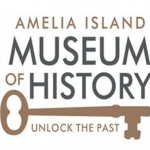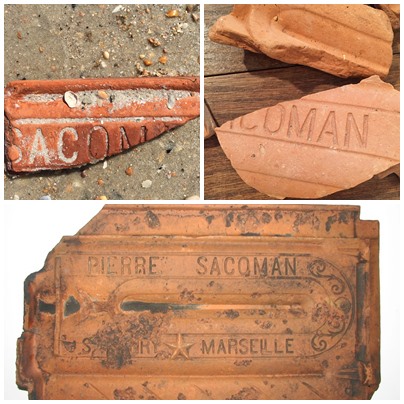 Amelia Island Museum of History
Amelia Island Museum of History
Jayne C. Nasrallah, Archivist
April 27, 2017 5:00 p.m.
Monday mornings often bring surprises at the Amelia Island Museum of History and Monday, April 3rd was one of those days. Sitting on one of the library tables was a plastic wash basin and a plastic bucket full of inch thick, terra cotta fragments. Hundreds of them! They were left with only a scrap of paper with a name and phone number as references to their origins.
 When the fragments were spread out on the table they were found to be remarkably clean and their edges were rounded not jagged. On the fragments were the impressions of letters forming recognizable words: Pierre, St Henry, and most of what had to be Marseilles. That suggested a French origin. There were also the letters, COMAN with something in front of them but offering no clue as to what those letters might be. And symbols too- a star and a vine-like inscription. Patterns and words repeated themselves suggesting that these were not the fragments of one original but of many similar pieces. What could these fragments possibly be and where had they come from?
When the fragments were spread out on the table they were found to be remarkably clean and their edges were rounded not jagged. On the fragments were the impressions of letters forming recognizable words: Pierre, St Henry, and most of what had to be Marseilles. That suggested a French origin. There were also the letters, COMAN with something in front of them but offering no clue as to what those letters might be. And symbols too- a star and a vine-like inscription. Patterns and words repeated themselves suggesting that these were not the fragments of one original but of many similar pieces. What could these fragments possibly be and where had they come from?
A library volunteer attempted to reassemble a whole out of the hundreds of pieces. If you imagine taking three or more identical jigsaw puzzles wearing the edges off all of the pieces and then mixing the pieces together and you will have a sense of the degree of difficulty of this task. Meanwhile the person who had collected the fragments was reached. She said they came from beyond the marker sign at the westernmost part of Fort Clinch State Park. Reportedly there were hundreds and hundreds of fragments still on the beach. Once the location of the fragments was known, figuring out what they were was much easier. That beach has long been known as Ballast Point. This is the location used by ship’s captains for decades to unload the heavy material they filled their hulls with to stabilize their ships on the way to pick up valuable cargo. When they neared their destination the ballast was unloaded onto a convenient shore. These fragments could have come from one ship or many. But these where not simple stones, these fragments were manufactured for some reason. What had they been intended to be?
A trip to Ballast Point (to photograph, not to collect) yielded the next clue. Yes, there are hundreds of terra cotta pieces imbedded in the sand. One of them clearly read SACOM. The full word was: SACOMAN! That turned out to be the magic word, as its entry into Google yielded photographs of whole roof tiles with all the letters and symbols found on the fragments. An architectural museum in Sydney, Australia had a detailed entry about the history and manufacture of the tiles.
The original items were terra cotta roof tiles manufactured by Pierre Sacoman, St Henry, Marseille, France, 1890- 1914. A full chapter of the book, Forty Years of Wunderlich Industry 1887-1927 describes and illustrates their production. Whole tiles can also be found in Argentina and India. Clearly these tiles are world travelers. But our tile fragments, interesting as they are, were never a part of a building. They were part of a recycling project of the late 19th and early 20th century. Broken tile pieces probably from the port city of Marseilles were put to good use stabilizing ships on their way to collect merchant goods. While their peers went on to cover homes around the world (and we know they were produced for export as only the tiles made for export were red in color) our fragments were waste. Who knew hundred year old garbage could be so interesting?
 The fragments have been photographed and will be entered as digital archives in the museum’s collection. They confirm a part of our local history we know well. The port of Fernandina has done business with the whole world. Ships carried off small fortunes of cargo and left behind the ballast that had helped them safely arrive here. The actual fragments have been returned to their rightful home, Ballast Point. There they can continue to delight beachcombers curious as to their purpose and origin. It is illegal to remove artifacts from state parks, so please enter Fort Clinch legally through the main gate, enjoy the beach and all its treasures, take photos, wonder what ship brought these items here and what it carried back to its destination. But please leave the fragments as they lay for others to wonder at and enjoy.
The fragments have been photographed and will be entered as digital archives in the museum’s collection. They confirm a part of our local history we know well. The port of Fernandina has done business with the whole world. Ships carried off small fortunes of cargo and left behind the ballast that had helped them safely arrive here. The actual fragments have been returned to their rightful home, Ballast Point. There they can continue to delight beachcombers curious as to their purpose and origin. It is illegal to remove artifacts from state parks, so please enter Fort Clinch legally through the main gate, enjoy the beach and all its treasures, take photos, wonder what ship brought these items here and what it carried back to its destination. But please leave the fragments as they lay for others to wonder at and enjoy.
